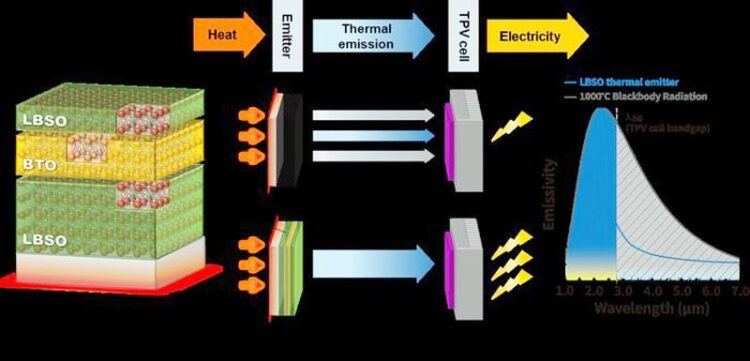Developing thermal radiation controllable epsilon-near-zero material

This diagram illustrates the effects of applying LBSO thermal emitter to TPV technology. In the case of a typical blackbody, when it absorbs heat, it emits radiant energy over a very broad wavelength range. However, this results in the emission of radiation energy at wavelengths that cannot be utilized by TPV cells, leading to reduced efficiency. By applying LBSO thermal emitters, it can selectively emit heat in the wavelength range where the TPV cells have the highest efficiency, increasing the overall energy generation efficiency.
Credit: Korea Institute of Science and Technology(KIST)
…that can withstand extreme environments.
Unlike conventional refractory conductimaterials, it not oxidizeand maintains performance at temperatures up to 1,000°C in air. Expected to be used in a wide range of extreme environments, including space, aerospace and thermophotovoltaic(TPV) system.
Thermal radiation is electromagnetic radiation emitted by all objects with temperature and most representatively, there is the solar radiation spectrum that enters the Earth and causes the greenhouse effect. Controlling and utilizing the thermal radiation energy emitted from solar power, thermal power generation, and residual heat in industrial sites can reduce the cost of electricity production. Therefore, interest in radiation spectrum controlling technology is increasing in areas such as cooling, heat dissipation, and energy production. Until now, radiation spectrum control technology has been mainly used in general environmental conditions, but recently, materials that can withstand extreme environments such as space, aviation and TPV system are needed.
Korea Institute of Science and Technology (KIST) announced that a team led by senior researcher Jongbum Kim at the Nanophotonics Research Center has developed a refractory material for controlling thermal radiation spectrum that maintains optical properties even at high temperatures of 1,000°C in air atmosphere and strong ultraviolet illumination.
The team fabricated lanthanum-doped barium stannate oxide (“LBSO”) as a nanoscale thin film with no lattice strain by pulsed laser deposition. Unlike conventional refractory conducting materials such as tungsten, nickel, and titanium nitride, which are easily oxidized at high temperatures, the LBSO material maintained its performance even when exposed to high temperatures of 1,000°C and intense ultraviolet light of 9 MW/cm2. The researchers then fabricated a thermal emitter based on a multilayer structure with high spectral selectivity in the infrared band using LBSO, and found that the multilayer structure was stable to heat and light as with the single layer thin film, confirming its applicability to TPV power generation technology. The LBSO material allows thermal radiation to be transferred to the PV cell without any additional methods to prevent it from oxidizing in contact with air.
“As an alternative to solar and wind renewable energy, whose electricity production varies depending on the weather, eco-friendly thermoelectric power generation technology that uses radiant energy emitted by the Sun and high-temperature environments to generate electricity is gaining attention,” said KIST senior researcher Jongbum Kim. “LBSO will contribute to addressing to climate change and the energy crisis by accelerating the commercialization of thermoelectric power generation.”
The researchers expect that LBSO can be applied not only to thermoelectric power generation technology and recycling of waste heat from industrial equipment, but also to technology for managing heat generated by exposure to and absorption of strong sunlight in extreme environments such as space and aviation, as it is highly resistant to UV exposure.
KIST was established in 1966 as the first government-funded research institute in Korea. KIST now strives to solve national and social challenges and secure growth engines through leading and innovative research. For more information, please visit KIST’s website at https://eng.kist.re.kr/
The research, which was supported by the Ministry of Science and ICT (Minister Jong-ho Lee) through the Information and Communication Technology Development Project and Standard Development Support Project (RS-2023-00223082) and the KIST Future Source Research Project, was published in the international journal Advanced Science (IF: 15.1, JCR(%): 6.2) was published on Nov. 23.
Journal: Advanced Science
DOI: 10.1002/advs.202302410
Article Title: Perovskite Lanthanum-Doped Barium Stannate: A Refractory Near-Zero-Index Material for High-Temperature Energy Harvesting Systems
Article Publication Date: 23-Nov-2023
All latest news from the category: Materials Sciences
Materials management deals with the research, development, manufacturing and processing of raw and industrial materials. Key aspects here are biological and medical issues, which play an increasingly important role in this field.
innovations-report offers in-depth articles related to the development and application of materials and the structure and properties of new materials.
Newest articles
Faster, more energy-efficient way to manufacture an industrially important chemical
Zirconium combined with silicon nitride enhances the conversion of propane — present in natural gas — needed to create in-demand plastic, polypropylene. Polypropylene is a common type of plastic found…

Energy planning in Ghana as a role model for the world
Improving the resilience of energy systems in the Global South. What criteria should we use to better plan for resilient energy systems? How do socio-economic, technical and climate change related…

Artificial blood vessels could improve heart bypass outcomes
Artificial blood vessels could improve heart bypass outcomes. 3D-printed blood vessels, which closely mimic the properties of human veins, could transform the treatment of cardiovascular diseases. Strong, flexible, gel-like tubes…





















